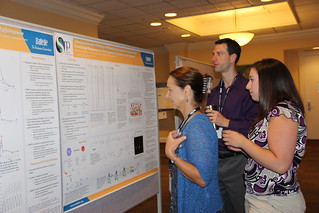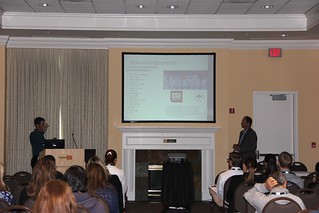
Alan J Bergmann
Project 4 |
Fractionation of Passive Sampling Device Extracts Explores Contribution of PAHs to Zebrafish Toxicity
Alan J Bergmann, Kim A Anderson, Robyn L Tanguay
Polyethylene passive sampling devices (PSDs) deployed in the Portland Harbor Superfund megasite have previously been used to correlate PAH concentrations with effects in embryonic zebrafish. However, spatial and temporal differences were not completely explained. The current work describes HPLC fractionation of PSD extracts to further investigate the role of PAHs in the toxicity of similar samples. Passive sampling devices were again deployed in Portland Harbor river water and extracted for parallel analysis by GC/MS and toxicity testing. Zebrafish embryos were exposed to the whole and chemically fractionated PSD extract which demonstrated a reproducible response in specific fractions. With concurrent chemical analysis we provide empirical evidence for contribution to these effects by discrete sample constituents. In addition, we show blank PSD extracts and sample manipulations to be non-toxic to zebrafish.
|

Narumol Jariyasopit
Project 5 |
Nitro-PAH Product Formation from Heterogeneous Reactions of PAHs with NO2 , NO3/N2O5, and OH radicals: Prediction, Laboratory Studies and Mutagenicity
Narumol Jariyasopit, MELISSA MCINTOSH, KATHRYN ZIMMERMANN, JANET AREY, ROGER ATKINSON, PAUL HA-‐YEON CHEONG, RICH G. CARTER, TIAN-‐WEI YU, RODERICK H. DASHWOOD, STACI L. MASSEY SIMONICH
The heterogeneous reaction of benzo[a]pyrene-‐d12, benzo[k]fluoranthene-‐d12, benzo[ghi]perylene-‐d12, dibenzo[a,i]pyrene-‐d14, and dibenzo[a,l]pyrene, with atmospheric oxidants, including NO2, NO3/N2O5, O3, and OH radicals, were investigated at room temperature and atmospheric pressure in a Teflon chamber, using quartz fiber filters (QFF) as a substrate. The analyses of parent polycyclic aromatic hydrocarbons (PAHs) and nitro products in the analytical extracts were conducted using gas chromatographic mass spectrometry. In addition, the filter extracts were tested in the Salmonella mutagenicity assay, using Salmonella typhimurium strain TA98 (with and without metabolic activation), to determine changes in mutagenic activities upon exposures. In parallel to the laboratory experiments, a theoretical study was conducted to assist in determining the formation of NPAH isomers based on the OH radical-‐initiated reaction.
This study has shown that the NO2 and NO3/N2O5 were effective oxidizing agents in transforming PAHs deposited on filters to nitrated-‐PAHs (NPAHs), with benzo[a]pyrene-‐d12 being the most readily nitrated. The relatively lower molecular weight PAHs studied, including benzo[a]pyrene-‐d12, benzo[k]fluoranthene-‐d12 and benzo[ghi]perylene-‐d12, yielded more than one mono-‐nitro isomer product, whereas the higher molecular weight PAHs studied, dibenzo[a,i]pyrene-‐d14 and dibenzo[a,l]pyrene, resulted in the formation of only one mono-‐nitro isomer product. The direct-‐acting mutagenicity increased the most after NO3/N2O5 exposure, particularly for benzo[k]fluoranthene-‐d12 in which dinitro PAHs were observed. |

Andrew Larkin
Project 1 |
Developing New Technologies for Complex PAH Mixture Risk Assessment
Andrew Larkin, Lisbeth K. Siddens, Sharon K. Krueger, Susan C. Tilton, Katrina M. Waters, David E. Williams, William M. Baird.
Polycyclic aromatic hydrocarbons (PAHs) are present in the environment as complex mixtures. Numerous individual PAH compounds have been studied and determined to have a wide range of carcinogenic potencies from known human carcinogen (benzo[a]pyrene ) to not classifiable as a human carcinogen (several PAHS, e.g.pyrene, phenanthrene). Carcinogenic potency of PAH mixtures, however, is less well defined. Previous studies in the William Baird lab have identified non-additive tumorigensis and gene expression responses in mouse skin after dermal exposure to PAH mixtures. The Baird lab has continued to build upon these mixture studies and narrow the gap between research, risk assessment and community engagement using semi-empirical modeling and smartphone technologies. A fuzzy neural network was developed to predict changes in murine dermal cyp1b1 mRNA expression after dermal exposure to combinations of individual PAH compounds and PAH mixtures. Predicted expression levels were within 1 log2 fold change unit of measured expression levels for all treatment groups, with the exception of dibenzo[def,p]chrysene. Environmental models of atmospheric fine particulate matter, coarse particulate matter, and ozone were also created and integrated into smartphone technology for predicting and preventing unwanted co-exposures of the modeled pollutants for members of the general population. |

Steven G. O’Connell
Project 4 |
Novel Technologies for OPAH and PAH Identification in Personal and Environmental Complex Mixtures
Steven G. O’Connell, Glenn Wilson, and Kim A. Anderson
Passive samplers have been used to examine dissolved, bioavailable fractions of organic compounds in air, water, and sediments for over a decade. Due to the intra-molecular forces inherent in silicone, this material may be optimized for monitoring less studied or emerging organic compounds such as oxygenated-PAHs (OPAHs) found in oil spills, near urban areas or National Priority Listed Superfund sites. Recent studies have characterized OPAHs as an emerging class of organic contaminants with concentrations and toxicities approaching or surpassing those of unsubstituted PAHs. Silicone materials have been tested in our laboratory for a wide range of emerging and legacy organic compounds including OPAHs, and found to sequester compounds in multiple field sampling events including two Superfund sites. Silicone PSDs were able to sequester and identify 20 PAHs, and 7 OPAHs in Superfund deployments from 10-1030 ng mL-1 per compound in the extract. In addition, adaption of this passive sampling technique has led to the development of an easy to use and effective personal monitoring device that identified 16 PAHs and 2 OPAHs from roofers exposed to asphalt fumes during a normal work day period that ranged from 4.5-510 ng mL-1 for individual PAHs.
|

Lane Tidwell
Project 4 |
Utilization of a Passive Sampling Device to Assess Environmental Concentrations and the Air-Water Flux of PAHs Before, During, and After the Deepwater Horizon Oil Spill
Lane Tidwell, Steven O’Connell, Glenn Wilson, Kim A. Anderson
The Deepwater Horizon oil spill introduced an estimated 4.1 million barrels of crude oil into the aqueous environmental compartment of the Gulf of Mexico. The oil released from the well head was composed of 3.9% Polycyclic Aromatic Hydrocarbons PAHs by weight, an estimated 2.1 X 1010g of PAHs were released into the water. Freely dissolved PAHs in the aqueous environment can volatilize to the atmospheric vapor phase. Low density polyethylene base passive sampling devices were used to collect air and water samples of the vapor and dissolved phase respectively at four sites in four states along the coast of the Gulf of Mexico. Sampling was conducted from May 2010 to October 2011. Samples were analyzed by GC/MS for thirty three parent and alkylated PAHs. Σ33 PAH concentrations in air ranged from 1.02 to 24.08 ng/m3. Σ33 PAH water concentrations ranged from 2.99 to 174.41ng/L. Flux direction of phenanthrene in Louisiana was from air to water for all sampling events.
|
 2013 International Symposium on Polycyclic Aromatic Compounds (ISPAC 2013)
2013 International Symposium on Polycyclic Aromatic Compounds (ISPAC 2013)









